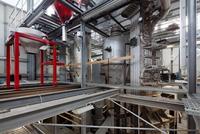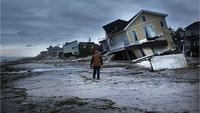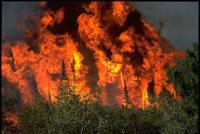-
Using waste heat to capture CO2 before it goes up in smoke

Power plants fired by coal and natural gas account for about half of the CO2 that humans add to the atmosphere each year; these power plants are prime candidates for new technology that captures CO2 before it goes up in smoke. Researchers seek to optimize CO2 removal from power plant emissions by employing waste heat. This is just one example of looking to improve upon a tried-and-true technology for CO2 capture. That technology — a two-phase chemical process — has been used for decades to remove naturally occurring CO2 from natural gas.
-
-
U.S. suffered $119 billion in disaster-related losses in 2012

Natural and man-made disasters contributed to $186 billion in economic losses around the world last year. The United States took the biggest hit with $119 billion in losses. Insurance claims for weather-related losses in 2012 totaled $77 billion dollars, the third most expensive losses on record. Nine of the top ten most expensive insured loss events which occurred last year happened in the United States.
-
-
A more powerful terahertz imaging system developed
Low-energy terahertz radiation could potentially enable doctors to see deep into tissues without the damaging effects of X-rays, or allow security guards to identify chemicals in a package without opening it. An electrical engineering research team has developed a laser-powered terahertz source and detector system which transmits with fifty times more power and receives with thirty times more sensitivity than existing technologies. This offers 1,500 times more powerful systems for imaging and sensing applications.
-
-
Suppressing naturally occurring blazes increases wildfire risk

According to the National Interagency Fire Center, 9.3 million U.S. acres burned in wildfires in 2012 compared with 3.57 million acres affected in 2001 and 2.95 million in 1991. One reason for the increase in the number of acres consumed by wildfires is the U.S. government’s policy of suppressing of naturally occurring blazes. Researchers say that this policy can have unintended consequences, including making wildfires more severe.
-
-
DHS seeking student hackers
DHS Secretary Janet Napolitano on Tuesday said that due to “new and rapidly growing threats” of a cyberattack, hundreds of college-age hackers are needed to help deal with the massive number of daily incursions into the nation’s electrical grid and other critical infrastructure.
-
-
More than 10,000 pesticides approved by EPA without rigorous review
Congress allowed the Environmental Protection Agency (EPA) to use what is called “conditional registration” to approve pesticides deemed especially beneficial for food production – even before all the toxicity tests have been completed. Congress intended conditional registration to be used only sparingly, but the EPS has been using the loophole in a wholesale fashion to approve 65 percent – or more than 10,000 – of the 16,000 pesticides submitted to it for approval. The EPA cannot easily track the history of conditionally approved pesticides to determine whether required toxicity data was submitted, whether that caused a dangerous use of a pesticide to be cancelled, or whether the uses or restrictions should be modified based in such data.
-
-
Focusing on climate’s impact on fisheries leads to misguided conclusions
In the early 1940s, California fishermen hauled in a historic bounty of sardine at a time that set the backdrop for John Steinbeck’s novel Cannery Row. By the end of the decade, however, the nets came up empty and the fishery collapsed. Where did they all go? A new study argues that the problem in seeking answers to this – and similar – questions lies in the fact that researchers typically try to find the answers by focusing on one factor at a time. What is the impact of climate on sardines? What is the effect of overfishing on sardines? Focusing on single variables in isolation can lead to misguided conclusions, the authors of the study say. The authors argue that climate, human actions, and ecosystem fluctuations combine to influence sardine and other species populations, and therefore such factors should not be evaluated independently.
-
-
Fluctuating wind power as a solution rather than a problem
Incorporating wind power into existing power grids is challenging because fluctuating wind speed and direction means turbines generate power inconsistently. Coupled with customers’ varying power demand, many wind-farm managers end up wasting power-generation capacity and limiting the service life of turbines through active control in order to avoid any possible damage to the power grid from spikes in supply.
-
-
Understanding the threat of invasive species

Catching rides on cargo ships and fishing boats, many invasive species are now covering the U.S. shorelines and compromising the existence of American native marine life. Once invasive species arrive in their new location, they begin multiplying, and in some cases, overpowering the local marine life.Researchers examine what factors allow some invasive species to survive in their new environments and others to fail.
-
-
NOAA predicts drought, flooding, warm weather for spring
The U.S. National Oceanic and Atmospheric Agency (NOAA) yesterday issued the three-month U.S. Spring Outlook, saying Americans should brace themselves for the following: above-average temperatures across much of the continental United States, including drought-stricken areas of Texas, the Southwest, and the Great Plains. These areas, and Florida, will see little drought relief owing to below- average spring precipitation. River flooding is likely to be worse than last year across the country.
-
-
Day of the nuclear battery nears

Experts in nuclear physics have helped develop research toward a “nuclear battery,” which could revolutionize the concept of portable power by packing in up to a million times more energy compared to a conventional battery.
-
-
Improved weather, climate predictions strengthen the U.S. economy
The economic costs of damaging weather events have an immense and increasing impact on the U.S. economy. These costs could be anticipated and mitigated by improved weather and climate predictions, say a range of experts in the public and private sectors. These experts will meet in early April in an American Meteorological Society event to discuss the economic benefits of how environmental forecast, prediction, and observation programs and services strengthen the U.S. economy.
-
-
New technology for carbon-dioxide capture, clean coal reaches milestone

An innovative new process which releases the energy in coal without burning — while capturing carbon dioxide, the major greenhouse gas — has passed a milestone on the route to possible commercial use.
-
-
Loss of summer rains lead to long droughts in southwest U.S.
Long-term droughts in southwestern North America often mean failure of both winter and summer rains, according to new research. The finding contradicts a commonly held belief regarding the region — that a dry winter rainy season is generally followed by a wet summer season, and vice versa. In fact, when severe, decades-long droughts have struck the area in centuries past, both winter and summer rains generally were sparse year after year.
-
-
Does warmer climate mean stormier, or only wetter, weather?
Many scientists argue that the climate has warmed since people began to release massive amounts greenhouse gases to the atmosphere during the Industrial Revolution. These scientists, however, are less sure that warming climate creates stormier weather. The reason: nobody has done the quantitative analysis needed to show this is indeed happening. Until now.
-
More headlines
The long view
Autonomous Vehicle Technology Vulnerable to Road Object Spoofing and Vanishing Attacks
Researchers have demonstrated the potentially hazardous vulnerabilities associated with the technology called LiDAR, or Light Detection and Ranging, many autonomous vehicles use to navigate streets, roads and highways. The researchers have shown how to use lasers to fool LiDAR into “seeing” objects that are not present and missing those that are – deficiencies that can cause unwarranted and unsafe braking or collisions.
Tantalizing Method to Study Cyberdeterrence
Tantalus is unlike most war games because it is experimental instead of experiential — the immersive game differs by overlapping scientific rigor and quantitative assessment methods with the experimental sciences, and experimental war gaming provides insightful data for real-world cyberattacks.
Prototype Self-Service Screening System Unveiled
TSA and DHS S&T unveiled a prototype checkpoint technology, the self-service screening system, at Harry Reid International Airport (LAS) in Las Vegas, NV. The aim is to provide a near self-sufficient passenger screening process while enabling passengers to directly receive on-person alarm information and allow for the passenger self-resolution of those alarms.
Falling Space Debris: How High Is the Risk I'll Get Hit?
An International Space Station battery fell back to Earth and, luckily, splashed down harmlessly in the Atlantic. Should we have worried? Space debris reenters our atmosphere every week.
Testing Cutting-Edge Counter-Drone Technology
Drones have many positive applications, bad actors can use them for nefarious purposes. Two recent field demonstrations brought government, academia, and industry together to evaluate innovative counter-unmanned aircraft systems.
Strengthening the Grid’s ‘Backbone’ with Hydropower
Argonne-led studies investigate how hydropower could help add more clean energy to the grid, how it generates value as grids add more renewable energy, and how liner technology can improve hydropower efficiency.
